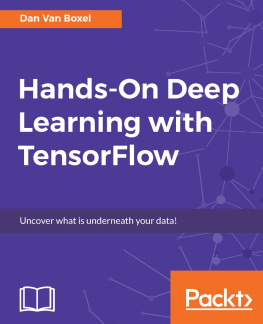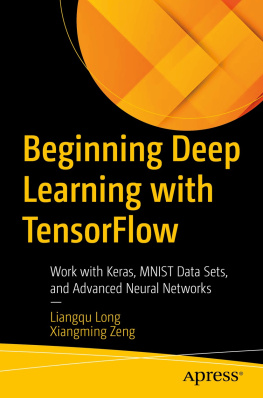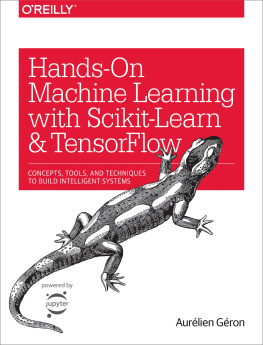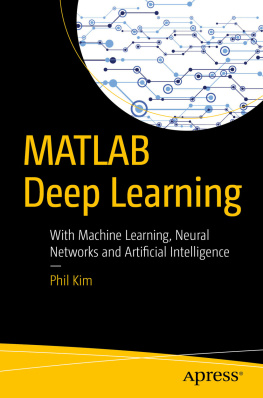Ahmed Menshawy - Deep Learning By Example: A hands-on guide to implementing advanced machine learning algorithms and neural networks
Here you can read online Ahmed Menshawy - Deep Learning By Example: A hands-on guide to implementing advanced machine learning algorithms and neural networks full text of the book (entire story) in english for free. Download pdf and epub, get meaning, cover and reviews about this ebook. year: 2018, publisher: Packt Publishing, genre: Home and family. Description of the work, (preface) as well as reviews are available. Best literature library LitArk.com created for fans of good reading and offers a wide selection of genres:
Romance novel
Science fiction
Adventure
Detective
Science
History
Home and family
Prose
Art
Politics
Computer
Non-fiction
Religion
Business
Children
Humor
Choose a favorite category and find really read worthwhile books. Enjoy immersion in the world of imagination, feel the emotions of the characters or learn something new for yourself, make an fascinating discovery.

- Book:Deep Learning By Example: A hands-on guide to implementing advanced machine learning algorithms and neural networks
- Author:
- Publisher:Packt Publishing
- Genre:
- Year:2018
- Rating:4 / 5
- Favourites:Add to favourites
- Your mark:
Deep Learning By Example: A hands-on guide to implementing advanced machine learning algorithms and neural networks: summary, description and annotation
We offer to read an annotation, description, summary or preface (depends on what the author of the book "Deep Learning By Example: A hands-on guide to implementing advanced machine learning algorithms and neural networks" wrote himself). If you haven't found the necessary information about the book — write in the comments, we will try to find it.
Grasp the fundamental concepts of deep learning using Tensorflow in a hands-on manner
Key Features- Get a first-hand experience of the deep learning concepts and techniques with this easy-to-follow guide
- Train different types of neural networks using Tensorflow for real-world problems in language processing, computer vision, transfer learning, and more
- Designed for those who believe in the concept of learn by doing, this book is a perfect blend of theory and code examples
Deep learning is a popular subset of machine learning, and it allows you to build complex models that are faster and give more accurate predictions. This book is your companion to take your first steps into the world of deep learning, with hands-on examples to boost your understanding of the topic.
This book starts with a quick overview of the essential concepts of data science and machine learning which are required to get started with deep learning. It introduces you to Tensorflow, the most widely used machine learning library for training deep learning models. You will then work on your first deep learning problem by training a deep feed-forward neural network for digit classification, and move on to tackle other real-world problems in computer vision, language processing, sentiment analysis, and more. Advanced deep learning models such as generative adversarial networks and their applications are also covered in this book.
By the end of this book, you will have a solid understanding of all the essential concepts in deep learning. With the help of the examples and code provided in this book, you will be equipped to train your own deep learning models with more confidence.
What you will learn- Understand the fundamentals of deep learning and how it is different from machine learning
- Get familiarized with Tensorflow, one of the most popular libraries for advanced machine learning
- Increase the predictive power of your model using feature engineering
- Understand the basics of deep learning by solving a digit classification problem of MNIST
- Demonstrate face generation based on the CelebA database, a promising application of generative models
- Apply deep learning to other domains like language modeling, sentiment analysis, and machine translation
This book targets data scientists and machine learning developers who wish to get started with deep learning. If you know what deep learning is but are not quite sure of how to use it, this book will help you as well. An understanding of statistics and data science concepts is required. Some familiarity with Python programming will also be beneficial.
Table of Contents- Data science: Birds-eye view
- Data Modeling in Action - The Titanic Example
- Feature Engineering and Model Complexity - The Titanic Example Revisited
- Get Up and Running with TensorFlow
- Tensorflow in Action - Some Basic Examples
- Deep Feed-forward Neural Networks - Implementing Digit Classification
- Introduction to Convolutional Neural Networks
- Object Detection - CIFAR-10 Example
- Object Detection - Transfer Learning with CNNs
- Recurrent-Type Neural Networks - Language modeling
- Representation Learning - Implementing Word Embeddings
- Neural sentiment Analysis
- Autoencoders - Feature Extraction and Denoising
- Generative Adversarial Networks in Action - Generating New Images
- Face Generation and Handling Missing Labels
- Appendix - Implementing Fish Recognition
Ahmed Menshawy: author's other books
Who wrote Deep Learning By Example: A hands-on guide to implementing advanced machine learning algorithms and neural networks? Find out the surname, the name of the author of the book and a list of all author's works by series.




